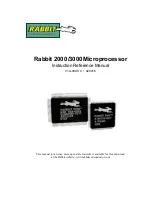
15 Instruction Set Reference
15 –12
The “SR OR” modifier (which is optional) logically ORs the result with the
current contents of the SR register; this allows you to construct a 32-bit
value in SR from two 16-bit pieces. “NORM” is the operator and “(HI)” is
the modifier that determines whether the shift is relative to the HI or LO
(16-bit) half of SR. If “SR OR” is omitted, the result is passed directly into
SR.
Table 15.5 gives a summary list of all Shifter instructions. In this list,
condition stands for all the possible conditions that can be tested.
Shifter Instructions
[IF condition]
SR
=
[SR OR] ASHIFT xop
(
HI
);
LO
[IF condition]
SR
=
[SR OR] LSHIFT xop
(
HI
);
LO
[IF condition]
SR
=
[SR OR] NORM xop
(
HI
);
LO
[IF condition]
SE
=
EXP xop
(
HI
);
LO
HIX
[IF condition]
SB
=
EXPADJ xop;
SR
=
[SR OR] ASHIFT xop BY <exp>
(
HI
);
LO
SR
=
[SR OR] LSHIFT xop BY <exp>
(
HI
);
LO
Table 15.5 Shifter Instructions
15.6
MOVE: READ & WRITE
MOVE instructions, shown in Table 15.6, move data to and from data
registers and external memory. Registers are divided into two groups,
referred to as reg which includes almost all registers and dreg, or data
registers, which is a subset. Only the program counter (PC) and the ALU
and MAC feedback registers (AF and MF) are not accessible.
Table 15.7 shows which registers belong to these groups. Many of the
system control registers are memory-mapped (for the processors with on-
chip memory); these registers are read and written as memory locations
instead of with register names.
















































